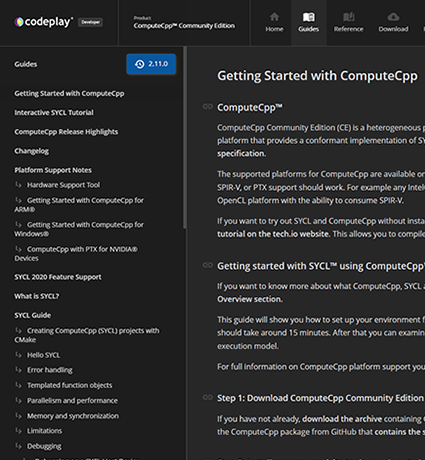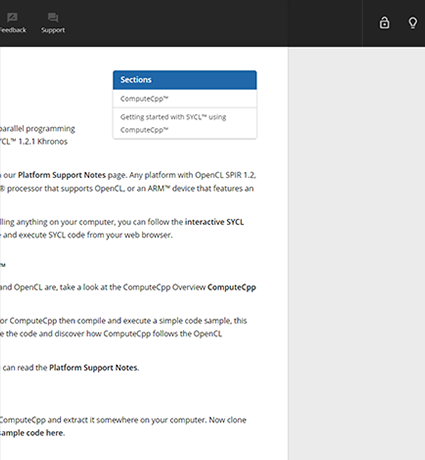Anatomy of a ComputeCpp App
ComputeCpp is a heterogeneous parallel programming platform that provides a conformant implementation of SYCL™ 1.2.1 rev 3 Khronos specification.
For information on the platforms that ComputeCpp supports, visit the Platform Support page.
ComputeCpp supports SYCL C++ libraries for better integration with C++ frameworks and applications like SYCL Parallel STL, math libraries like SYCL Eigen Tensor Library and machine vision libraries.
Figure 1. ComputeCpp Package Components
This package includes the compute++ SYCL device compiler and the SYCL Runtime library along with its headers. The ComputeCpp package can be downloaded from the Download page, and further details on how to integrate the ComputeCpp package to an existing C++ application can be found in the ComputeCpp Integration Guide.
The ComputeCpp SDK complements the ComputeCpp Package with build system integration, sample code and documentation. The ComputeCpp package is available at computecpp-sdk @ GitHub.
Further documentation of the system can also be found in the ComputeCpp API Documentation. There is a local copy of the API Documentation available in the directory doc/api_pages/index.html of the ComputeCpp package.
Writing SYCL™ code using ComputeCpp™
SYCL™ for OpenCL™ is a heterogeneous parallel programming interface which integrates modern C++ techniques with OpenCL™ 1.2 massively parallel device capabilities. A SYCL application is a C++ application that uses the SYCL API, in order to integrate with OpenCL platforms existing on the target system.
The following example depicts the basic structure of a SYCL application.
This example implements a simple addition of two vectors of scalar types on a SYCL device. The vectors are represented using std::array for simplicity.
Basic SYCL example
#include <CL/sycl.hpp>
#include <array>
constexpr cl::sycl::access::mode sycl_read = cl::sycl::access::mode::read;
constexpr cl::sycl::access::mode sycl_write = cl::sycl::access::mode::write;
template <typename T>
class SimpleVadd;
template <typename T, size_t N>
void simple_vadd(const std::array<T, N> &A, const std::array<T, N> &B,
std::array<T, N> &C) {
cl::sycl::queue deviceQueue;
cl::sycl::range<1> numOfItems{N};
cl::sycl::buffer<T, 1> bufferA(A.data(), numOfItems);
cl::sycl::buffer<T, 1> bufferB(B.data(), numOfItems);
cl::sycl::buffer<T, 1> bufferC(C.data(), numOfItems);
deviceQueue.submit([&](cl::sycl::handler &cgh) {
auto accessorA = bufferA.template get_access<sycl_read>(cgh);
auto accessorB = bufferB.template get_access<sycl_read>(cgh);
auto accessorC = bufferC.template get_access<sycl_write>(cgh);
cgh.parallel_for<class SimpleVadd<T>>(numOfItems,
[=](cl::sycl::id<1> wiID) {
accessorC[wiID] = accessorA[wiID] + accessorB[wiID];
});
});
}
int main() {
const size_t array_size = 4;
std::array<int, array_size> A = {{1, 2, 3, 4}},
B = {{1, 2, 3, 4}}, C;
std::array<float, array_size> D = {{1.f, 2.f, 3.f, 4.f}},
E = {{1.f, 2.f, 3.f, 4.f}}, F;
simple_vadd<int, array_size>(A, B, C);
simple_vadd<float, array_size>(D, E, F);
for (unsigned int i = 0; i < array_size; i++) {
if (C[i] != A[i] + B[i]) {
return 1;
}
if (F[i] != D[i] + E[i]) {
return 1;
}
}
return 0;
}
In this example, the addition of the two vector arrays is defined using a templated function simple_vadd. This function implements:
C = A + B
where A, B and C are vector arrays of the same type and size.
The contents of the std::array are initially stored on the host memory, as is usually done in C++ programs. In order to make the contents of the array available on the device, developers must create a SYCL memory object.
On line number <1>, we include CL/sycl.hpp. The ComputeCpp SYCL implementation uses this single header to include all the API interface and the dependant types defined in the API.
On line number <14>, we construct a cl::sycl::range object initialized to the size of the vectors (the template parameter passed to the function). Objects in SYCL are multi-dimensional, and the number of elements per component is expressed using the cl::sycl::range objects. A cl::sycl::range is a vector with as many components as dimensions. The value stored in each component expresses the size on that component, starting from 1. The range is used to create the cl::sycl::buffer object, which manages the data on host and device. In this case, since we use vectors, we only use one dimensional buffers (second template parameter). The objects bufferA, bufferB and bufferC are initialized with the pointer obtained from the std::array.
In SYCL, the execution of any computation on a SYCL device follows the OpenCL execution model. In this simple example, we use the default SYCL device chosen by the ComputeCpp runtime library on cl::sycl::queue construction.
The SYCL command group functor encapsulates the vector addition kernel alongside the input and output operations. On line number <19>, we define the lambda function (our command group functor) and submit it to the queue object deviceQueue.
The Command Group defines the Command Group Scope. Any object that takes a cl::sycl::handler object can only be used in Command Group Scope. The cl::sycl::handler object can only be constructed by the runtime. Device accessors and the Kernel Functor can only be defined in this scope.
The SYCL programming model uses accessors (the cl::sycl::accessor class) to keep track of the access from different command groups to memory objects. The SYCL runtime can then use the different access modes of the accessors to create a dependency graph, to schedule the execution of multiple command groups in different devices while maintaining a consistent view of the memory.
Accessors are obtained from buffers on lines <20> to <21>, by calling the get_access method on the buffers to create cl::sycl::accessor objects.
On line <20>, we require a read-only accessor on the queue’s device. The sycl_read variable is a constexpr variable of the enum class cl::sycl::access::mode. The declarations of sycl_read and the corresponding sycl_write are on lines <4> and <5>.
This example implements the simple_vadd computation in a SIMD(single instruction, multiple data) manner: the computation will be executed on multiple processing elements in parallel. This is the default parallel programming mode in SYCL.
The lambda function object defined at line numbers <24> to <27> defines the Kernel Scope. The lambda is called by the parallel_for function API. In the example, we spawn as many work-items as the number of elements of the vectors, specified in the numOfItems cl::sycl::range variable. The name of the kernel is specified as the template parameter of the parallel_for using the class type SimpleVadd 1
Note that this is not required when the parallel_for function is called using a functor object, the functor typename is going to be used as the SYCL kernel name.
The parallel_for invocation will execute the lambda function object as a SYCL kernel to an NDRange execution space. The NDRange consists of work-items organized into work-groups.
The parallel_for API used in the example is the simplest way of dispatching kernels to a SYCL device. The number of work-groups is defined by the heuristics of the ComputeCpp runtime: an nd-range will be implicitly constructed for the OpenCL execution of the SYCL kernel functor 2. In this example, simple_vadd is called for array_size equal to four on line number <39> and line number <40>. The number of work-items, numOfItems, is equal to four, so the number of work-groups can only be one, two or four as shown in the following diagram.
Figure 2. Vector Addition Diagram
On line number <26>, accessorC (a write-only accessor) is used to store the result of the addition of the read-only accessors accessorA and accessorB. Let’s take a simplified view of what the second work-item (wiID) of our four-element one-dimensional NDRange will do. The wiID[1] will add accessorA[wiID[1]] with accessorB[wiID[1]] and store it to accessorC[wiID[1]] (depicted in diagram parallel_for_execution).
On line number <25>, the lambda function object (that defines the Kernel Scope) takes as a parameter the current instance in the global index space class (cl::sycl::id). The cl::sycl::id class features various getter methods to obtain specific values of the instance. The value of wiID will change for each instance in the complete NDRange execution space. Note that SYCL allows using cl::sycl::id variables directly as index accessor types.
The cl::sycl::queue::submit method returns immediately after scheduling the command group functor to the SYCL queue for execution on the SYCL device. The command group functor will be executed on the device when the accessor dependencies are resolved and the device is ready to perform the "kernel dispatch".
In the main function of the C++ SYCL application, we define the size of the vectors to be array_size. On line <33>, we define the std::array vectors A, B and C using the SYCL type cl::sycl::cl_int. All cl_XXX types defined in the SYCL namespace that are types portable between C++ host and device. ComputeCpp can convert the host type to the corresponding device type in this case. Normal host types (e.g, int) can still be used, but the interoperability is not defined, and sizes may vary between host and device. 3.
On line number <36>, we are calling the simple_add templated function for cl_int and array_size, providing as parameters the array objects of A, B and C. Note that on line number <37>, we are calling the simple_add templated function for float and array_size for the std::array objects D,E and F. This shows one of the main features of SYCL: since the SYCL interface is templated, we can write generic algorithms that can be instantiated with different types without changing the algorithm, interacting nicely with C++ programming.
-
C++ lambda functions are unnamed function objects which capture variables in scope. Due to the fact that ComputeCpp is following the single source multiple pass technique, using a host and a device compiler, that name is going to be used for identifying the function object across the different compilers. ↩
-
If a
cl::sycl::nd_rangeobject is given to theparallel_forinvocation, the SYCL runtime will be using the explicitly specified NDRange. ↩ -
compute++ is not going to change the type defined by the developer on the device side unless it is defined as a SYCL OpenCL interoperability type, e.g. cl_int, cl_long, etc. ↩


